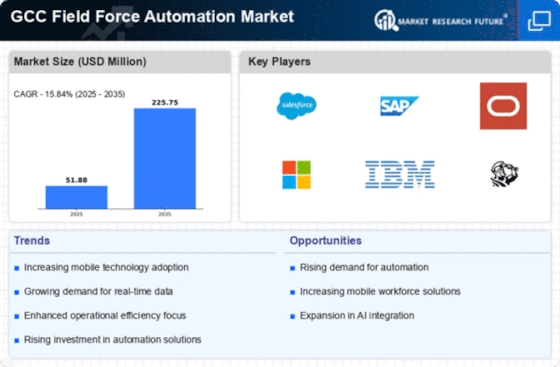GCC Field Force Automation Market Segment Insights
Field Force Automation Market Type Insights
The GCC Field Force Automation Market is witnessing substantial growth, driven largely by the increasing need for efficient and streamlined operations across various industries. This growth is significantly influenced by the segmentation into Solutions and Services. Solutions primarily encompass software platforms that facilitate automation in field operations, enhancing real-time communication, data collection, and overall productivity for companies operating in sectors such as telecommunications, oil and gas, and logistics. The growing adoption of cloud-based solutions within the GCC region has allowed businesses to effectively manage their workforce while reducing operational costs.
Meanwhile, Services play a crucial role in supporting these solutions, encompassing installation, maintenance, and ongoing support that ensure smooth functionality and integration of automated systems into existing workflows. These services are vital as they aid businesses in maximizing their return on investment, allowing them to adapt to rapidly changing market demands and technological advancements. The emphasis on digital transformation across the GCC countries has further propelled investments in both Solutions and Services, making them significant contributors to the overall market.Organizations are increasingly acknowledging the importance of optimizing field operations, which has led to a growing focus on the development of innovative solutions tailored to address specific industry needs.
Additionally, the rising emphasis on data-driven decision-making amplifies the relevance of customized services that can help companies utilize data analytics effectively. The ongoing expansion of smart technologies and Internet of Things applications in the GCC region promises to drive the demand for advanced field force automation solutions, positioning this segment as a key driver for market growth in the coming years.Thus, the GCC Field Force Automation Market showcases a robust framework where Solutions and Services not only coexist but also synergize to foster enhanced operational efficiency and productivity across various sectors.

Source: Primary Research, Secondary Research, MRFR Database and Analyst Review
Field Force Automation Market Deployment Insights
The Deployment segment of the GCC Field Force Automation Market is critical in shaping the overall market dynamics, reflecting a growing reliance on advanced technologies to enhance operational efficiency. Within this segment, the On-Premise deployment model provides organizations with control over their data and systems, making it particularly appealing for industries that prioritize security and compliance. On the other hand, the Cloud deployment model is rapidly gaining traction due to its flexibility, scalability, and cost-effectiveness, allowing businesses to adapt quickly to changing market demands and streamlining their field operations.
Recent government initiatives in the GCC region aimed at digitizing public services and supporting smart cities further boost the adoption rates of these deployment models. The increasing demand for real-time data access and the necessity for improved communication and collaboration between field personnel are key growth drivers for the Deployment segment. As organizations continue to seek innovative solutions to optimize workforce management and enhance customer satisfaction, the importance of both On-Premise and Cloud deployments will remain pronounced, illustrating the evolving nature of the GCC Field Force Automation Market.
Field Force Automation Market Organization Size Insights
The GCC Field Force Automation Market exhibits diverse dynamics based on organization size, primarily segmented into Small and Medium Enterprises (SMEs) and Large Enterprises. SMEs are increasingly recognizing the significance of field force automation as a means to enhance operational efficiency and service delivery. This segment is driven by the need for cost-effective solutions that can streamline processes without extensive resource demands. On the other hand, Large Enterprises predominantly invest in sophisticated field force automation systems, integrating advanced technologies to manage vast operations and improve data analytics.This allows them to enhance decision-making and optimize workforce management.
The growth in sectors such as logistics, utilities, and telecommunications in the GCC region further fuels the demand for tailored automation solutions. Government initiatives aimed at digital transformation and economic diversification also bolster the adoption rates among varying organizations. The rising trend of remote work and the necessity for real-time performance monitoring underpin the importance of these sub-segments, highlighting their vital role in shaping the GCC Field Force Automation Market landscape.Additionally, as competitive pressure amplifies, both SMEs and Large Enterprises must leverage automation to maintain market relevancy and operational efficiency.
Field Force Automation Market Vertical Insights
The Industry Vertical segment of the GCC Field Force Automation Market plays a pivotal role in enhancing operational efficiencies across various sectors. The IT and Telecommunication industry emphasizes the integration of advanced technologies to streamline communication and improve service delivery, significantly driving market growth. Meanwhile, the Manufacturing sector benefits from automation in field operations, aiding in maintaining production schedules and resource management, thereby gaining a competitive edge. In Healthcare, the focus on patient management and service delivery is paramount, leading to increased demand for field force solutions that ensure timely medical attention.Transportation and Logistics are critical for efficient supply chain management, with automation facilitating real-time tracking and optimized routing.
The Energy and Utilities sector sees automation as a crucial component for monitoring and managing resources effectively, ensuring sustainability and efficiency in operations. As organizations in these industries increasingly recognize the need for effective field force automation technologies, the GCC region is set to witness significant advancements that contribute to overall productivity and service quality in these sectors.The market continues to adapt to evolving industry demands, highlighting the importance of technology in modern operations across the GCC landscape.


















Leave a Comment